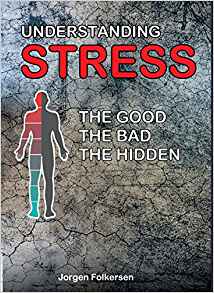Understanding Stress
The Good, The Bad, The Hidden


Jorgen Folkersen started out studying to be a medic, but was diverted into medical research and thence health assessment and research management in the public health and pharma sectors. The exposure to medical research and management roles sparked a fascination in how mental development advice for Leaders and elite sportsmen, which has focused in on stress prevention and management.
Folkersen’s research has made him aware that knowledge regarding stress is not even widely understood amongst therapists in the sector and that accessible and connected information on the topic is hard to find. This book is his endeavour to fill this gap.
There is no definition of when ‘stress is harmful, harmless or even constructive’. Stress is not officially regarded as an ‘illness’ though its effects can be debilitating. ‘Stress is usually a natural, non-harmful condition that allows the body and psyche to adapt to temporary peak loads’. Everyone reacts to stress in their own way, some can even react to most severe trauma with personal growth, while others would be severely mentally affected.
Folkersen adopts an emerging definition for levels of stress: toxic, acute and positive. Toxic stress, is a chronic condition that harms us. This can be physical, caused by stress-related hormones or behaviour changes. It can accelerate our ageing (at any age), it can lead to increased weight (stressed bodies tend to accumulate visceral (belly) fat more quickly and often reduces subcutaneous fat reserves, visceral fat can feed the brain’s energy needs more efficiently – but is more damaging overall). Stress also increases risk of cardiovascular diseases and reduces the immune system, making wounds slower to heal, asthma attacks mor likely, auto-immune diseases more prevalent (eg rheumatoid arthritis), and clear evidence it is connected to the incidence of bowel diseases, diabetes and cancer.
Toxic stress also affects our conscious thoughts ‘with the short-term goal of protecting our psyche from painful experiences and feelings’. Children are particularly vulnerable to hidden stress, leading to behaviour and mental issues emerging in later life. For managers and others affected by stress at work, consequences can include reduced awareness, altered senses of reality, reduced memory, dream affected sleep, avoidance, irritation and anger, reduced cognitive function and empathy. None of these is conducive to increased performance for individuals or their organizations.
Folkersen underlines how many of these effects can be self-reinforcing, so deepening and lengthening the stress episodes, creating a vicious circle. He also distinguishes between PTSD that is usually associated with a single traumatic event and Complex-PTSD that can be built up from multiple stressors, often psychosocial ones (as are more likely to occur in a work environment), over a long period of time. C-PTSD has many of the same characteristics as PTSD however.
Acute stress can provoke many of these same negative consequences, particularly from highly traumatic events. Other short-term stress events can however create positive benefits increasing motivation and resilience.
Managerial workers are twice as likely to take time off work due to stress than other employees. Nonetheless it is the second most cited reason for work absence (after minor illnesses/colds). If stress at work is not addressed, the obvious effect is increased absences of employees, however the more damaging ‘hidden’ effect is reduced employee effectiveness and so performance, not to mention the damage to individuals well-being.
This book is written for a practitioner audience, but the author’s background in academic research does come through. This gives it depth and authority, but can make it harder to digest. The core message is clear however long-term stress is damaging and the work environment is a fertile one for it to be created.
Title: Understanding Stress, The Good, The Bad and The Hidden
Author/s Name/s: Jorgen Folkersen
Publisher: Mind-eduction
ISBN: 978-87-970146-1-5
Publishing Date: May 2018
Number of Pages: 218
Author Knowledge Rating: 1-5 (based on their years of experience, academic expertise in subject areas, and exposure to cross-functional thinking in the area)





















































Readability: 1-5 score(1=dense and v academic; 5=frantic; page turner)



























































Appropriate Length: (1=could have been written in 25% of the length;5=could have been longer)



























































Core Idea Value: (1=nonsense (or entirely esoteric); 5=game-changer)


































































